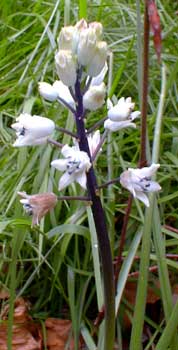 Roman Hyacinth; or,
Roman Hyacinth; or,
Jacinthe Romaine; or,
Roman Squill
"And Spring arose on the garden fair,
Like the Spirit of Love felt everywhere;
And each flower & herb on Earth's dark breast
Rose from the dreams of its wintry rest."
-Percy Shelley
(1792-1822)
(1792-1822)
Bellevalia species are related to Muscaris, although the majority of them are much humbler in their appearance. B. romana, native of southern France & Mediterranean Europe, was first described in 1806, but has never become a garden standard, no doubt because it is insufficiently showy & requires subtler appreciation.
It has a purple stem of lose bell-shaped flowers typical of the genus, resting amidst floppy scilla-like grass. When the stem of little blooms is still mostly in bud, the top can have a cluster reminiscent of Grape Hyacinth, except of a dulled coloration that can be quite varied but mainly flat green to olive, though on some strains the initial bud-cluster is closer to white, or bluish-green. In the main, when in full flower, it has open-mouthed bells loose upon the stem, instead of the dense pinch-mouthed florets of most types of Grape Hyacinth.
It has enough in common with related genuses that it has formerly been categorized as Hyacinthus romanus, & as Scilla romana. Extremely hardy, but slow to propogate, it looks best when mixed with Grape Hyacinths or some other colorful early spring bloomer. It does not generally have a sufficient impact to hold a lot of attention by itself.
In our zone it is budding no later than mid-March & in full flower all of April & sometimes a little ways into May. The bluish to olive green buds open white for the lower florets, while the upper blooms mature to a pale fawn-brown with violet tinge.
These subdued "greenish-brownish-whitish" colors, alas, do sometimes make the blossom look soiled or prematurely fading, but in their prime, with the lowermost white florets wide open & tipped slightly upward to reveal their very dark blue anthers, they can be terribly charming. The purple stems are occasionally showier than the blooms. The blooms possess a very light scent of vanilla or almond, but it would take a great many of them to have any impact of redolence.
We have one other species Bellevalia, B. pycnantha, but that one is a Grape Hyacinth look-alike, the most ornamental of the genus. B. romana by comparison is a humble wildflower without showiness. Even so, collectors who love to spot "minor" things in the garden such as might go unnoticed by superficial observers, B. romana will have a distinct appeal.
We planted a scant three bulbs just inside the dripline of our Weeping Green Beech & keep the weeping limbs about two feet off the ground so that sunlight reaches the few small things planted beneath. The bulbs might fail to naturalize in this location. They rather prefer prairie conditions of moist springs & dry summers, in full sun, & perfect drainage is essential. I'm hoping the beech's quick use of water in summer will mean the bellevalia bulbs are never too wet in summer, but if they don't come back evey year, I'll know in the future to put B. romana bulbs only amidst things that require much less watering during our very dry summers.